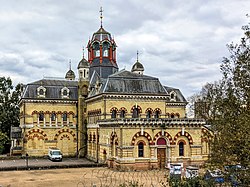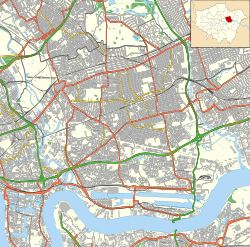| Abbey Mills Pumping Station | |
|---|---|
 The main building in 2022 | |
| General information | |
| Status | in use |
| Type | pumping station |
| Architectural style | Italian Gothic |
| Address | Abbey Lane, Mill Meads |
| Town or city | London |
| Country | England |
| Coordinates | 51°31′51″N0°00′03″W / 51.5307°N 0.0008°W |
| Construction started | 1865 |
| Completed | 1868 |
| Design and construction | |
| Architect(s) | Charles Driver |
| Engineer | Joseph Bazalgette |
Listed Building – Grade II* | |
| Designated | 6 November 1974 |
| Reference no. | 1190476 |
Abbey Mills Pumping Station is a sewage pumping station in Mill Meads, East London, operated by Thames Water. The pumping station lifts sewage on the London Main Drainage sewerage system into the Northern Outfall Sewer and the Lee Tunnel, which both run to Beckton Sewage Treatment Works.
Contents
- History
- Purpose
- Modern pumping station
- Lee Tunnel
- Thames Tideway Scheme
- Gallery
- References
- External links
The pumping station was designed by the architect Charles Driver [1] for the Metropolitan Board of Works Chief Engineer Joseph Bazalgette and was built between 1865 and 1868, housing eight beam engines by Rothwell & Co. of Bolton, two on each arm of a cruciform plan. [2] The architecture is an eclectic style related to Driver's railway station designs. Another of his designs, Crossness Pumping Station, is located south of the River Thames at Crossness, at the end of the Southern Outfall Sewer. [3]
A modern sewage pumping station (Station F) was completed in 1997 [4] about 200 metres (660 ft) south of the original station.





